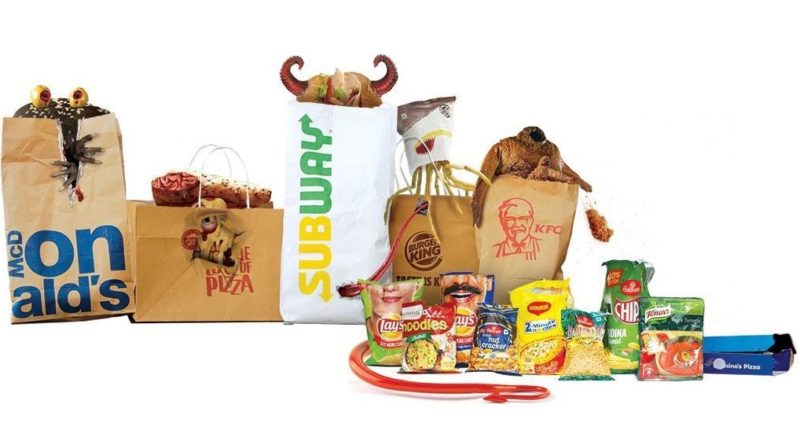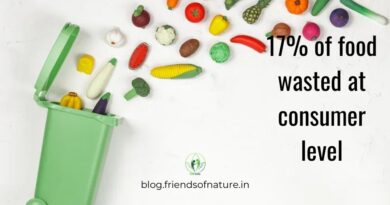Junk food monster: Communicating diseases
A lab study by the Centre for Science and Environment has found extremely high levels of salt, fat and trans fat in junk foods responsible for obesity and non-communicable diseases like hypertension, diabetes and heart ailments.
Think before you open the next pack of Haldiram’s Classic Nut Crackers or dig into a regular Non Veg Supreme Pizza from Domino’s. Only 35 grams of the scrumptious nut crackers would finish up around 35 per cent of your daily permissible salt intake and 26 per cent of the allowed fat consumption. And four slices of that cheesy pizza would make you consume 99.9 per cent of the day’s allowed salt and 72.8 per cent of fats.
Consumption of these junk foods, that are high in salt, fats and trans fats can have deadly impacts. Doctors say they are an open invitation to non-communicable diseases like diabetes, hypertension, heart ailments and even cancer.
“These diseases are difficult to manage if manifested early in life,” says Ambrish Mithal, head of the endocrinology and diabetes division, Medanta Hospital, Gurugram, Haryana. A 2016 report by the Indian Council of Medical Research (ICMR) shows a worrying trend — disease burden due to unhealthy diet, high blood pressure, high blood sugar, high cholesterol and being overweight has increased from 10 per cent to 25 per cent since 1990. And the victims, many a time, were ill-informed and unsuspecting consumers.
It never bothered Manjeet Singh, an advocate in Delhi, that her 11-year-old son gorged on packaged and fast foods every day. It kept him full and happy, and saved her a lot of time and trouble. Not until the boy started complaining of double vision and headaches. Manjeet was shocked when doctors said he had high blood pressure. “They strictly advised him to reduce weight, not eat junk food and adopt a low-salt diet, else he would be under the risk of cardiac problems and diabetes,” she says.
Manjeet could have helped her son had she known, upfront, what was inside those ultra-processed food packs.
The fine print declaring the amount of nutrients is not of much help. “With my vision, I would be spending the entire day buying food if I start reading them,” says Ashok Gulati, a 64-year-old retired professional. It’s impossible for 22-year-old Parvesh Sinha, a departmental store worker who never went to school, to know what he eats.
The Centre for Science and Environment (CSE), a Delhi-based research and advocacy non-profit, had shaken up the country in 2012 when it found high amounts of salt, fat, trans fat and carbohydrate in foods people love to eat. Seven years later, where exactly do we stand?
To understand this, between July and October 2019, CSE’s Environment Monitoring Laboratory again tested their content in 33 popular packaged and fast foods marketed by Indian and multi-national companies and available across the country.
The samples were collected from grocery stores and fast food outlets in Delhi. The lab used internationally accepted testing methods listed by the Association of Official Analytical Chemists (AOAC). Carbohydrate in these foods was tested by the widely used colorimetry method.
The lab results were used to understand how much of each nutrient contributes to the recommended dietary intake for the Indian population. It corelated the results with the serving size or weight of the products to understand the actual intake. The results, to say the least, were shocking.
Chips and namkeens had way more salt and fat than one should consume in a snack. Instant noodles and soups had too much salt.
The analysis was based on the Recommended Dietary Allowance (RDA), derived after reviewing the recommendations of World Health Organization (WHO), National Institute of Nutrition-India, ICMR and the scientific expert groups of the Food Safety and Standards Authority of India (FSSAI).
The RDA for salt was reached at 5g, 60 g fat and 300 g carbohydrate for one person in a day. The trans fat limit was 2.2 g. The calculations were made taking into account the accepted 2,000 kilocalorie that a healthy person requires in a day.
Considering we have three meals in a day and two snacks, our mealtime consumption of these nutrients should not be more than 25 per cent of RDA, and the two main snacks of the day must not add more than 10 per cent of RDA. Now take a look at what the CSE lab tests found.
Chips and namkeens
What’s advertised by Indian cricket captain Virat Kohli as a healthy and “Smart option for smart snacker” is, in fact, unhealthiest in terms of salt. Of all the chips packets tested, Too Yumm Multigrain Chips had the maximum salt — 1 g in 30 g of chips.
In other words, 30 g of this gives double the day’s allowance of salt from a snack. And even a healthy green vegetable or a leafy salad becomes a source of extra salt. So think again before grabbing on the second snack of the day if you have already munched on Too Yumm Multigrain Chips.
In fact, all the chips tested either had high salt or high fat, or both. Lay’s India’s Magic Masala, Uncle Chipps Spicy Treat and Haldiram’s Chips Pudina Treat exceeded 10 per cent RDA of both salt and fat. One-fifth of the day’s fat RDA gets blown away if one consumes one serve of Haldiram’s Chips Pudina Treat.
Worse, there are chips packets that mention 30 g as the serving size — the amount allowed for consumption — but are not available in that size only. For instance, the Rs 20 pack of Lay’s American Style Cream and Onion that weighs 52 g, mentions 30 g as its serving size.
In effect, it offers more chips than one can consume in one go. So before relaxing on the sofa with a packet of chips, read the fine print and do the mental math to know exactly how many can be enjoyed without getting worried about health.
Haldiram’s Chips Pudina Treat does not even mention the serving size. In fact, it attracts consumers by offering them extra chips. Too Yumm Multigrain Chips gives vague information on the serving size. It says: “Image is a pictorial reference of serving suggestion”. While the picture shows only four-five chips, that’s definitely not how much children stop with.
Eating chips frequently results in dental problems, a common ailment otherwise left ignored. “Chips are sticky and remain in the oral cavity for long hours. Soon, they start to ferment resulting in tooth decay and cavities,” says Praveen Chaudhary, senior dentist and head of the department at Jaypee Hospital in Noida, Uttar Pradesh.
CSE’s lab tested four varieties of namkeens. All but one had high salt and fat content, but Haldiram’s Classic Nut Cracker had criminally high salt, exhausting almost 35 per cent of RDA — much higher than one should consume in one full meal. It mentions the 35-g serving size only on its website. Checking this online before tearing the pack open is a difficult proposition.
Haldiram’s Aloo Bhujia exhausts more than 21 per cent of the salt RDA. But there’s no way consumers can know how much salt they consume from these namkeens and chips.
Of the 14 packed foods CSE tested, 10 declare sodium in their products, not salt, which leaves the consumer misinformed. Three don’t declare sodium or salt. Only one declares salt. Manjeet, for instance, carefully read the nutritional information of the chips her son regularly munches on, but could not tell how much salt he consumes.
Clearly, food companies are complicating facts. One should consume not more than 2 g sodium in a day, but companies give the information in mg. Now do the mental math one more time.
Instant noodles and soup
Akshat, a 13-year-old school student, eats Nestle Maggi Masala instant noodles twice or thrice a week. It’s easily available in his school canteen. But a 70-g pack of this puts 2.6 g salt into our body.
Patanjali, which promotes its Atta Noodles Chatpata with the punchline ‘Jhatpat Banao, Befikr Khao’, contains 2.4 g salt in one pack. Remember, 5 g is all that is allowed through the day.
Ching’s Secret Schezwan goes a step further. It labels less than half the amount of what it actually contains, according to CSE’s lab results.
Similarly, instant soup is popular in winters, but is definitely not a healthy option. Just one serve of Knorr Classic Thick Tomato soup can exhaust over one-fourth of the daily salt limit.
And people love to have it as a starter before meals. So, even a healthy meal afterwards can shoot up your daily salt intake, that too within a short period. As consumers misconstrue these as fresh food for the cooking it involves, the industry makes hay.
Burgers and fries
Advertisements affect people’s senses and stimulate responses such as craving to eat. In the long run, this becomes a habit, says Uday Sinha, a professor at the Institute of Human Behaviour & Allied Sciences, Delhi.
In a recent full-page newspaper advertisement, McDonald’s made a disparaging comment on freshly cooked home food. It said: “Stuck with Ghiya-Tori again? Make the 1+1 combo you love.” Even FSSAI called it an irresponsible advertisement as it was against the national efforts to promote the right eating habits, especially among children. Read along to know how healthy McDonald’s combo is.
Eat one Chicken Maharaja Mac and your daily permissible salt intake is almost over in one go. It has 4.6 g salt, leaving only 10 per cent, or 0.4 g more for the entire day. The fat content is over half the prescribed daily limit for a meal.
A medium McDonald’s fries accounts for almost one-fifth of the daily fat need. The combo has an astounding 103 per cent salt, 72 per cent fat, 13 per cent trans fat and 33 per cent carbohydrate.
Unsuspecting vegetarians are not any luckier. A vegetarian Cheese Whopper from Burger King will leave you with just over a fourth of the daily salt quota and less than half of that for fat. As its regular fries accounts for almost one-fifth of the daily fat need, adding it to a combo meal, stuffs you with just too much nutrients.
Burger, fries and fried chicken from KFC’s 5-in-1 classic zinger box would give 20 per cent more fat than the day’s quota along with very high levels of salt and trans fat.
“Food companies know that India is a naive market for junk food. A large population is unaware of nutrition and good food. Junk food is being made and sold in a manner that it is addictive,” says Vandana Prasad, a community paediatrician. So think twice before you choose that combo meal over home-cooked food.
Smaller burgers are cheap and attract people. But their contribution to RDA is big. KFC’s Veg Zinger with cheese can exhaust up to three-fourths of the daily salt brink and 45 per cent of the fat limit. Its Chicken Classic Zinger with cheese finishes over 80 per cent of fat and over 60 per cent of salt threshold. Burgers with cheese have more trans fats.
Pizza, sandwich and wrap
Pizza is considered a healthy fast food meal option because of the vegetables it comes with, but CSE lab results found it is loaded with salt and fat, and has high levels of trans fat.
It tested vegetarian and non-vegetarian pizzas from Domino’s and Pizza Hut along with one sachet of oregano seasoning it comes with. These were regular or personal pizzas meant to be consumed by one person.
Domino’s Non Veg Supreme has about 5 g salt, while Peppy Paneer cheese burst has only slightly less. So, no more space for salt from any other food, if these pizzas are consumed.
Non-veg Supreme also exhausts about three-fourths of the permissible fat. This also provides high levels of unhealthy trans fat — about one-third of the limit. Pizza Hut’s Chicken Supreme has more salt than one needs for the day.
Even the humble Classic Tomato Margherita from Pizza Hut can add over 50 per cent of the daily salt intake, 25 per cent of fat and about one-fourth of the trans fat limit. Excessive trans fat content in all pizzas that were tested is a cause for concern.
CSE lab tests also examined sandwiches, often perceived as healthy food for the raw vegetables it uses. But the result was disturbing. Salt, fat and trans fat content in sandwiches are as high as in pizzas.
A 6-inch Subway Chicken Seekh Kabab sandwich has about 5 g salt, 39 g fat and 0.62 g trans fat. This is not just the amount of salt one can have in an entire day but also adds up to 65 per cent of the recommended fat levels and 28 per cent of trans fats.
Its vegetarian option, the Paneer Tikka sandwich, is not any healthier and exhausts over three-fourths of salt and fat limits, and one-fourth of trans fat limit. McDonald’s Big Spicy Paneer Wrap will give you about 4 g of salt and 45 g of fat.
Facts on trans fats
Trans fats are deadly. Their intake must be avoided to prevent heart diseases. CSE found that most food companies either do not disclose or give more than the amount they declare.
Haldiram’s Classic Nut Cracker, for instance, had 4.6 times trans fat it claims to have. Fast food companies Domino’s and Subway do not mention trans fats at all on their website.
But all four of their samples that CSE tested had high trans fats. Burger King and KFC mention 0 g, suggesting no trans fats. That’s not the case. Trans fats found in two pizza samples of Pizza Hut were higher than what the company declared.
“A diet high in trans fat can increase the risk of heart disease,” says Mithal of Medanta Hospital.
Clearly, companies are not bothered.
(Names of consumers have been changed to protect their identity)
Study by Mrinal Mallik, Arvind Singh Sengar and Rakesh Kumar Sondhiya Analysis by Amit Khurana and Sonal Dhingra
This was first published in Down To Earth‘s print edition (dated 16-31 December, 2019)




